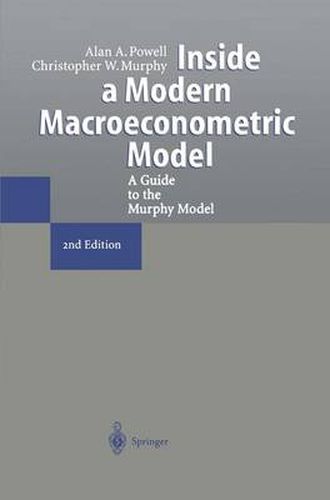Readings Newsletter
Become a Readings Member to make your shopping experience even easier.
Sign in or sign up for free!
You’re not far away from qualifying for FREE standard shipping within Australia
You’ve qualified for FREE standard shipping within Australia
The cart is loading…






This title is printed to order. This book may have been self-published. If so, we cannot guarantee the quality of the content. In the main most books will have gone through the editing process however some may not. We therefore suggest that you be aware of this before ordering this book. If in doubt check either the author or publisher’s details as we are unable to accept any returns unless they are faulty. Please contact us if you have any questions.
As Ken Wallis (1993) has pOinted out, all macroeconomic forecasters and policy analysts use economic models. That is, they have a way of going from assumptions about macroeconomic policy and the international environment, to a prediction of the likely future state of the economy. Some people do this in their heads. Increasingly though, forecasting and policy analysis is based on a formal, explicit model, represented by a set of mathematical equations and solved by computer. This provides a framework for handling, in a consistent and systematic manner, the ever-increasing amounts of relevant information. Macroeconometric modelling though, is an inexact science. A manageable model must focus only on the major driving forces in a complex economy made up of millions of households and fIrms. International economic agencies such as the IMF and OECD, and most treasuries and central banks in western countries, use macroeconometric models in their forecasting and policy analysis. Models are also used for teaching and research in universities, as well as for commercial forecasting in the private sector.
$9.00 standard shipping within Australia
FREE standard shipping within Australia for orders over $100.00
Express & International shipping calculated at checkout
Stock availability can be subject to change without notice. We recommend calling the shop or contacting our online team to check availability of low stock items. Please see our Shopping Online page for more details.
This title is printed to order. This book may have been self-published. If so, we cannot guarantee the quality of the content. In the main most books will have gone through the editing process however some may not. We therefore suggest that you be aware of this before ordering this book. If in doubt check either the author or publisher’s details as we are unable to accept any returns unless they are faulty. Please contact us if you have any questions.
As Ken Wallis (1993) has pOinted out, all macroeconomic forecasters and policy analysts use economic models. That is, they have a way of going from assumptions about macroeconomic policy and the international environment, to a prediction of the likely future state of the economy. Some people do this in their heads. Increasingly though, forecasting and policy analysis is based on a formal, explicit model, represented by a set of mathematical equations and solved by computer. This provides a framework for handling, in a consistent and systematic manner, the ever-increasing amounts of relevant information. Macroeconometric modelling though, is an inexact science. A manageable model must focus only on the major driving forces in a complex economy made up of millions of households and fIrms. International economic agencies such as the IMF and OECD, and most treasuries and central banks in western countries, use macroeconometric models in their forecasting and policy analysis. Models are also used for teaching and research in universities, as well as for commercial forecasting in the private sector.